 Philippines Landslide |
February 2006 Flooding produced a devastating landslide in the southeastern Philippines on February 17. Additional information can be found below. |

Across the United States, significant drought extended from the Desert Southwest eastward through the southern Plains. Exceptional drought classification continued through parts of Texas and into adjacent sections of Oklahoma and Arkansas, which generated unusually severe fire potential across the region. |
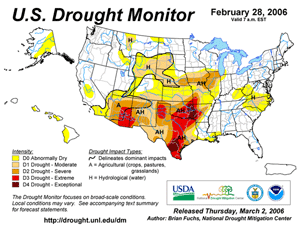 U.S. Drought Monitor |
For comprehensive drought analysis, see the U.S. drought report. |
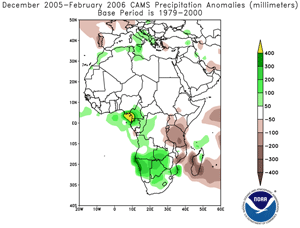 Africa Rainfall Anomalies |
A severe long-term drought continued throughout southern Ethiopia, southern Somalia, northeastern Kenya, as well as adjacent areas of eastern Uganda and Tanzania. Drought in Somalia was characterized as the worst in a decade (UNICEF). In all, an estimated 11 million people in East Africa and the Horn of Africa continued to face critical food shortages brought about in part by the continuing drought (IRIN). For the latest African analysis and forecast, see the Famine Early Warning System Network. |
A large dust storm affected areas of North Africa and adjacent areas of the eastern Mediterranean region during late February, producing major reductions in visibility over a large area. |
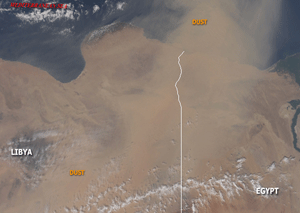 North Africa Dust Storm |


Heavy rainfall in northern Iraq produced extensive river flooding that displaced an estimated 7,000 families. The most affected areas included the towns of Erbil, Sallahaddin, Kirkuk, Dyiala and Missan (IFRC). |
 Iraq Flooding |
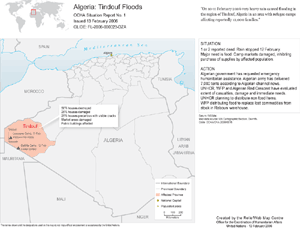 Flooding In Algeria |
In Algeria, rare heavy rainfall in the Sahara Desert region of Tindouf produced severe flooding. The rain fell during the 10th-11th in a desert region of Algeria not far from the Moroccan and Mauritanian borders. Approximately 50,000 people were affected, with one fatality reported (OCHA/AFP). |
In Papua New Guinea, heavy rainfall produced significant
flooding in the northwestern part of the country's Central Province
during mid February. The flooding rendered an estimated 10,000
people homeless and caused one fatality (IFRC)
|
 Papua New Guinea Flooding |
 Philippines Landslide |
In the southeastern Philippines, a deadly landslide triggered by heavy rainfall buried the village of Guinsaugon (population 1,400) on the 17th. As of the end of February 2006, there were 139 confirmed fatalities, 30 injuries and 980 people listed as missing (Government of Philippines). |
The Philippine Geosciences Bureau estimated the landslide at 4
meters (13 feet) deep, covering an area of approximately 3 square
kilometers (1.2 square miles).
|
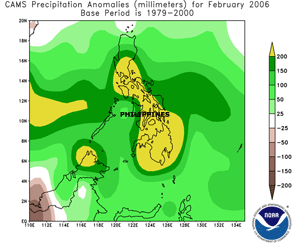 Philippines Rainfall Anomalies |
Across eastern Indonesia, landslides and floods caused by torrential rain on the 21st killed at least 33 people in the city of Manado (OCHA). |
In Yemen, heavy rainfall resulted in flash flooding on the 20th in the southwestern city of Dhamar. Floodwaters trapped around 1,900 people in their homes, and there were at least 5 deaths (AFP). |
In Lesotho, rainfall characterized as the heaviest in nearly two decades destroyed nearly one-third of the crops in the ground ahead of the April harvest (OHCA). |
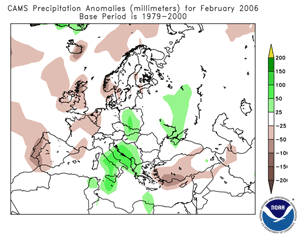 Europe Precipitation Anomalies |
Across Serbia, heavy rain and melting snow produced significant flooding in the province of Kosovo in late February. Flooding in at least fourteen municipalities forced the evacuation of an estimated 200 families (around 1,200 people) from their homes (IFRC). |


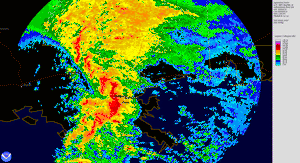 New Orleans Thunderstorms |
In the United States, severe thunderstorms produced two tornadoes that affected the New Orleans, Louisiana area during the early morning of February 2. The tornadoes affected neighborhoods ravaged by Hurricane Katrina, tearing off roofs, knocking down utility poles and collapsing at least one Katrina-damaged house. |


Tropical Cyclone Boloetse, which
formed in
late January, affected Madagascar for a second time in early
February as it tracked southeastward from the Mozambique Channel
during the 4th-5th. While the cyclone remained offshore, it tracked
close enough to the coastline to displace over 6,000 people, as
nearly 2,500 private homes were damaged or destroyed in the extreme
southern part of the country (UNICEF).
|
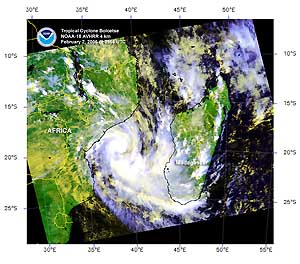 Tropical Cyclone Boloetse |
 Tropical Cyclone 12S |
Tropical Cyclone 12S developed in the south Indian Ocean, affecting Mauritius on the 19th-20th. Maximum sustained winds with the cyclone reached 85 km/hr (45 knots or 50 mph) before weakening as the system moved very slowly. |
Tropical Cyclone Emma developed in the
south Indian Ocean on the 27th and made landfall in Western
Australia's remote Pilbara coast on the 28th with maximum sustained
winds near 65 km/hr (35 knots or 40 mph). Heavy rain was the
primary impact from the storm, although Emma's approach prompted
precautionary shutdowns of mining, oil and shipping operations
(AAP).
|
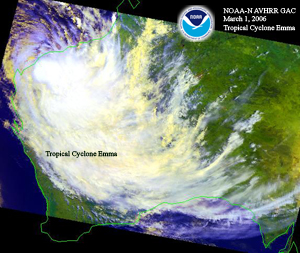 Tropical Cyclone Emma |
For 2006 basin tropical cyclone statistics, please refer to the
following:
|


No reports of significant extratropical cyclones were received during February 2006. |


A
major winter snowstorm affected areas of the Mid-Atlantic and
Northeast during February 11-12, 2006. In New York City's Central
Park, where record-keeping began in 1869, 68.3 cm (26.9 inches) of
snow fell between 4 p.m. Saturday and 4 p.m. Sunday, breaking the
previous all-time storm total record of 67.1 cm (26.4 inches) set
during a December 26-27, 1947 storm.
|
 Eastern U.S. Snow |
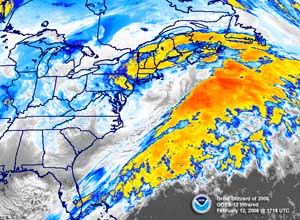 Blizzard Of 2006 |
In Hartford, CT, a snowfall total of 55.6 cm (21.9 inches) broke the old storm total record of 53.3 cm (21 inches) set in 1983. There were many reports between 25-51 cm (10-20 inches). |
 NOAA's National Centers for Environmental Information
NOAA's National Centers for Environmental Information
